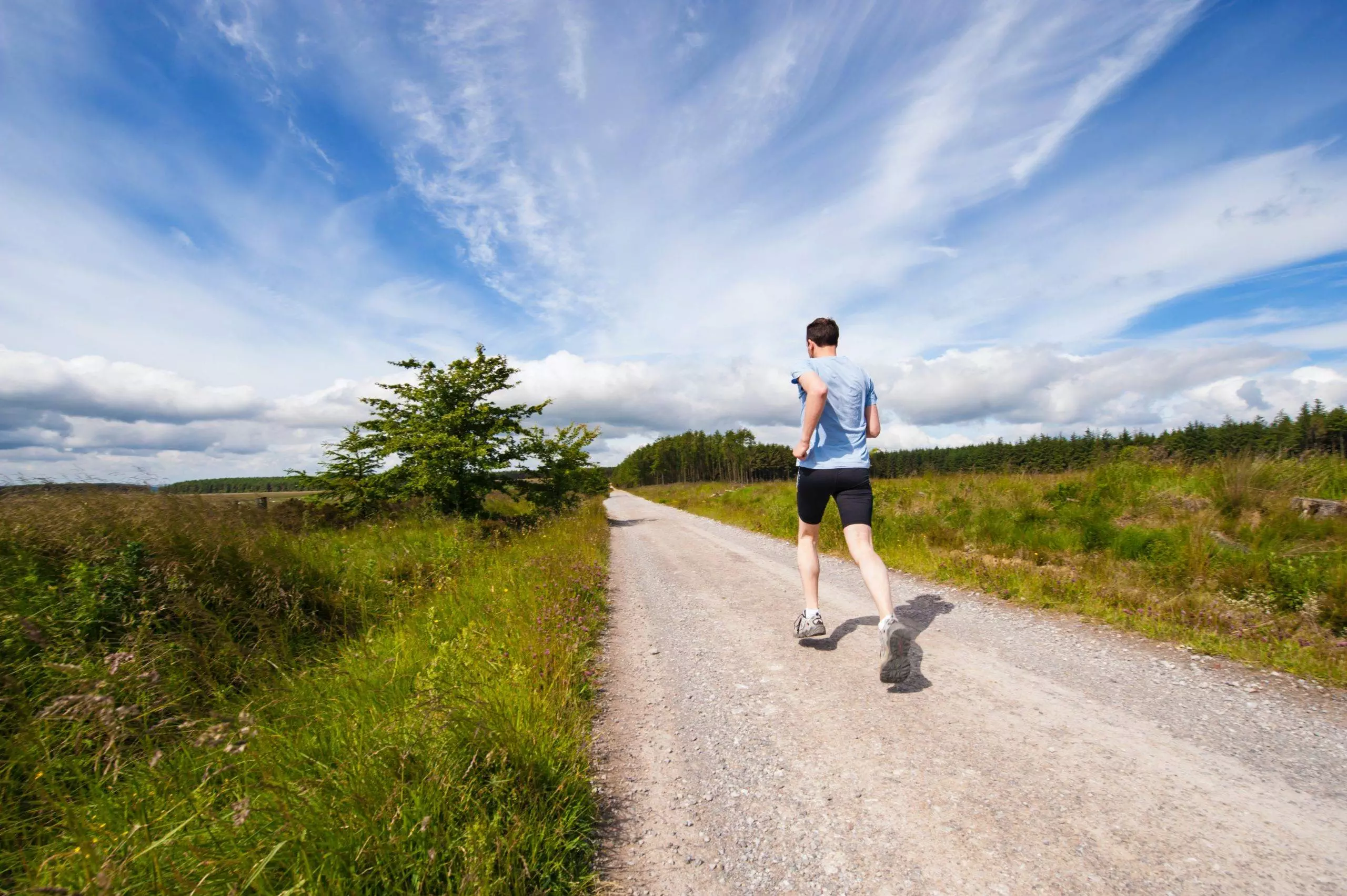Measuring workout intensity for running, and particularly trailrunning or fastpacking, can be difficult and subjective. Unlike other sports where the environment, terrain, or equipment is relatively consistent there are more variables at play when exercising on-trail and heart rate or pace do not provide the most accurate measure of workload. This is because factors such as vertical gain, altitude, dehydration, lack of sleep, poor nutrition, and fatigue can all impact your pace and heart rate and skew the results.
As such, Rate of Perceived Exertion (RPE) is widely used as the standard tool for measuring workload and improving fitness in endurance athletes. In this article we’ll take a look at how RPE came to be used in sports and how it applies to running.
The Borg Scale
In 1982, Swedish psychology professor Dr. Gunnar Borg introduced the concept of using RPE to measure workout intensity in a paper titled Psychophysical Bases of Perceived Exertion, published in Medicine and Science in Sports and Exercise journal. In his words,
Perceived exertion is the single best indicator of the degree of physical strain. The overall perceived exertion rating integrates various information, including the many signals elicited from the peripheral working muscles and joints, from the central cardiovascular and respiratory functions, and from the central nervous system. All these signals, perceptions, and experiences are integrated into a configuration or “Gestalt” of perceived exertion.
The original RPE scale included 15 grades loosely matched to heart rate, from 6 to 20, to gauge exertion:
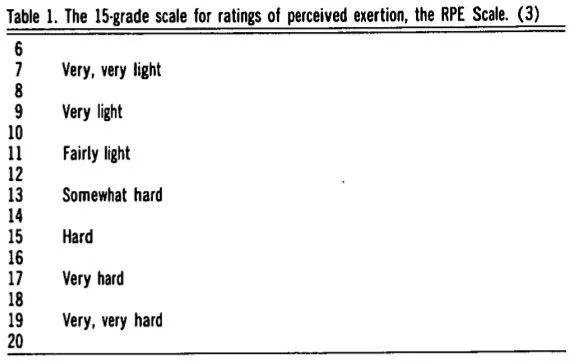
Borg chose this particular scale because he found that it correlated well to the athlete’s heart rate if multiplied by 10. For example, if someone was running very hard (17 on the RPE scale), their heart rate would generally be somewhat close to 170 beats per minute – though not always. Skeptics of the original RPE/heart rate method point out that there may be considerable differences between the perceived exertion and heart rate, no doubt impacted by the aforementioned factors.
Despite defending the calculation and maintaining that RPE and heart rate are complementary to one another, Borg also proposed a shorter scale of 1-10 which could be used by the “lay population and not restricted to those familiar with mathematical or technical terminology”. The linear scale is what is now utilized in most by most athletes and coaches based on its wide-ranging applicability and ease of comprehension.
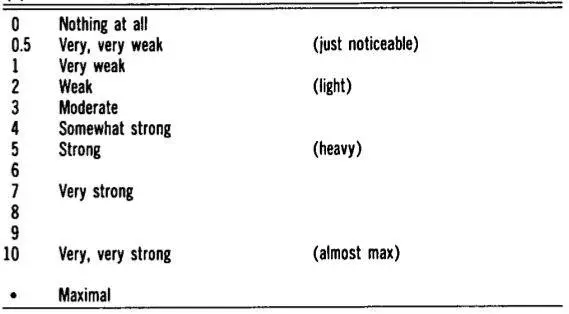
While Borg’s RPE scale was created as a measure of general physical stress it is often applied for ultrarunners who, as previously mentioned, have many variables to consider when calculating workload. When coaching athletes, Joe uses the 1-10 scale.
Applying RPE to Ultrarunning
RPE is is one of the most simple methods of calculating workout stress. There are no watches, monitors, or other technology required–rather it’s based on the athlete’s intuition. What does take practice, though, is understanding how to use RPE to elicit particular reactions and adaptations from your body which help to improve running performance. RPE is particularly beneficial for athletes who:
- Have difficulties taking easy days easy.
- Incorporate hills, trails or mountains into their training.
- Require a deep personal understanding of exertion for race purposes; i.e. ultramarathoners.
All aspiring endurance athletes should incorporate running workouts into regular training to prepare your muscles and cardiovascular system for an upcoming event. Like any type of exercise where increased performance is the goal, you must continually apply stress to your body and then rest to allow for adaptation. Over time and if done properly, you will become stronger, faster, and fitter.
RPE can be your guiding light for the right amount of training stress. For example, If you find yourself continually hitting a 6 or 7 RPE on easy days, you are not allowing your body enough rest. If you are running a hill workout and you are lost trying to identify a pace or heart rate zone, use RPE. In longer races, heart rate data gets wonky pace is a fool’s errand. If you have trained off of RPE, your intuition of your race effort will offer a huge competitive advantage over competitors.
Jason Koop, an endurance coach and author, pioneered a series of running workouts and RPE zones based on these principles which he has outlined in blog posts as well as his book Training Essentials for Ultrarunning: How to Train Smarter, Race Faster, and Maximize your Ultramarathon Performance –an excellent read. We have adapted these foundations, as well as those from other well known coaches like Matt Fitzgerald, author of 80/20 Running: Run Stronger and Race Faster By Training Slower, and use them ourselves as well as with coaching clients to develop run workouts based on RPE zones which serve distinct purposes and target different physiological attributes related to performance.
RPE Zones
As described above, each type of workout is designed to elicit a specific adaptation in the runner. To do that, various ranges of effort, called RPE zones, are applied to those workouts. A summary of the common zones and their associated RPE ranges are below, however it’s important to understand that proper prescription of workouts based on these thresholds in a given training block is necessary to maximize gains and reduce the possibility of injury. More on that later.
Recovery
The recovery zone is not so much a workout as the absence of one. The idea is to turn the legs over to increase blood flow to recovering muscles and elevate your heart rate up a bit without taxing your body. The pace should be conversational at an RPE of 2 to 3, whatever that means for you. The recovery zone is used for workouts following hard efforts or long runs and will last one hour or less.
Endurance and Endurance Nearing Aerobic Threshold (ENAT)
Endurance effort is where you will spend a majority of your running time. This is known as your “all day pace”, with the idea that you should be able to maintain it for hours on end during an event. The intensity is above that of a recovery run but still comfortable. The intended RPE for endurance efforts is 4 to 5 with an adjusted pace based on terrain–e.g. slow down when going uphill to avoid bumping up intensity into the next category of workout. A typical endurance workout could be anywhere from one to eight hours or more depending on the event you’re training for. For ENAT, the intensity is increased slightly (closer to 6) and the pace is one that could be held for about 2 hours.
Aerobic Threshold
Efforts at your aerobic threshold is not sustainable over extended periods. Workouts in this zone are crucial to improving your aerobic capacity because they increase your endurance pace with minor progressive overload. The RPE zone of aerobic threshold exertions should be 7 with individual intervals ranging between 20 and 75 minutes for a total of up to 2 hours at intensity.
Critical Velocity to Lactate Threshold (CVLT)
The CVLT zone is a step up from aerobic threshold in terms of intensity and targets improvements in your lactate threshold, which is important even if your goal is distance. The zone for these efforts is 8 RPE, at which you will only be able to sustain intervals of 8 to 35 minutes with a combined one hour or less at intensity.
VO2 Max
The VO2 Max zone is one you will love to hate. It is generally applied to maximum-effort, short-duration intervals lasting from under one minute to three minutes with an approximately 1:1 workout to recovery effort. These will generally be book-ended by warm-up and cool-down efforts and possibly a series of strides (20-second bursts of high-intensity effort to prepare you for longer speed intervals). At 9 RPE, you are targeting your VO2 max, while a 10 RPE workout focuses on muscular fitness.
|
Summary of RPE Zones |
||
| Zone | Target RPE |
Description |
|
Recovery |
2-3 |
Comfortable breathing, easy recovery effort to encourage circulation. |
|
Endurance |
4-5 |
Your “all day” pace for long runs and warmups/cooldowns. |
|
ENAT |
6 |
Rythmic, moderate breathing, not labored. Strong but comfortable pace you could maintain for 2+ hours, used in steady state workouts. |
|
Aerobic Threshold |
7 |
Deep and controlled breathing. A strong effort that is uncomfortable but not unbearable. Pace is bearable for runs over an hour and used in steady state workouts. |
|
CVLT |
8 |
High-intensity intervals of 8-20 minutes. |
|
VO2 Max |
9-10 |
Maximum or near maximum effort. Short and rapid breathing. Reached during speed & hill workouts. |
Running Workouts using RPE Zones
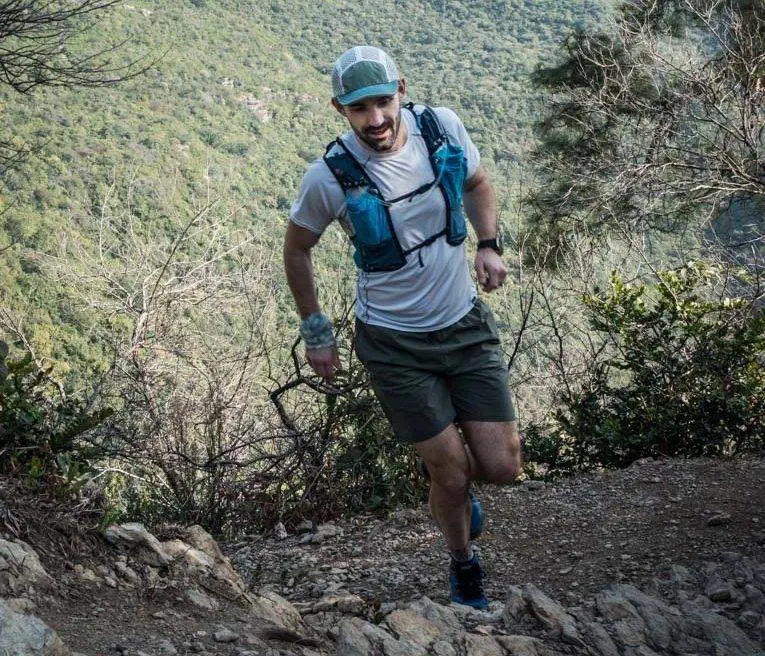
As mentioned, the usefulness of RPE zones is when they are applied to running workouts. Joe generally prescribe 4 types of workouts based off of the threshold zones described above. While workouts are intended to be a hard effort, certain types of workouts will target different physiological systems and offer unique training adaptations.
- Speed workout: Develop running economy and VO2 max. Very intense efforts @9 RPE. 8-25 minutes of time spent at the target pace usually done around a track in intervals.
- Hill workout: Develop running economy, VO2 max and ultra specific muscle strength. Very intense efforts @9 RPE. 8-25 minutes of time spent at the target pace done on a hill or treadmill in intervals.
- Tempo workout: Improve lactate threshold. Intense pace 15-30 seconds slower than 5k pace @8 RPE. 20-40 minutes of time spent at the target pace in a single block or intervals.
- Steady state workout: Build aerobic threshold and develop fat burning metabolic system. Moderate effort @6-7 RPE. 30-90 minutes of time spent at the target pace.
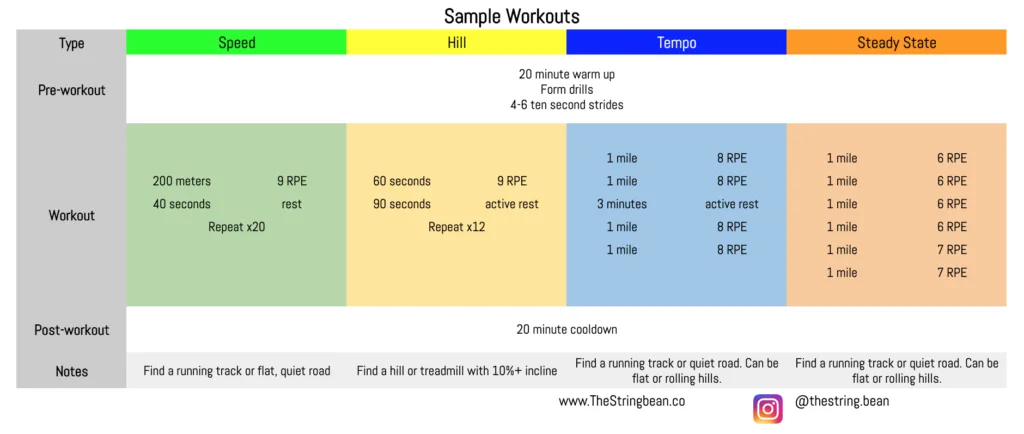 All intervals, speed or otherwise, can be performed on any type of terrain including tarmac, trails, or treadmills. That being said, elevation impacts the outcome. Doing speed work on flat surfaces is better for leg turnover and form efficiency, while hill workouts train athletes for mountainous races and build ‘sneaky speed’ without significant muscular/skeletal damage. This is because you are able to reach the desired intensity quickly and with less downward force, due to the grade, on your muscles, tendons and bones.
All intervals, speed or otherwise, can be performed on any type of terrain including tarmac, trails, or treadmills. That being said, elevation impacts the outcome. Doing speed work on flat surfaces is better for leg turnover and form efficiency, while hill workouts train athletes for mountainous races and build ‘sneaky speed’ without significant muscular/skeletal damage. This is because you are able to reach the desired intensity quickly and with less downward force, due to the grade, on your muscles, tendons and bones.
RPE As an Indicator of Fatigue and Improvement
RPE is a multi-faceted tool that provides lots of useful information not only about your running but also about your current condition. For example, if you’re well-rested then running at an RPE of 7 might equate to a pace of 8 minutes-per-mile on most days. If you find yourself consistently needing more effort to keep a steady pace, e.g. it feels more like an RPE of 8 instead of its usual 7, then that’s a good indication that you may be experiencing fatigue and need to dial back your training to avoid injury and decreased performance.
Similarly, RPE can be used to show improved fitness. If your 8 minute-per-mile pace rated at a 7 initially but felt more like a 5 or 6 later in the year, that would indicate significant progress.
While other data points like heart rate variability, elevated heart rate and pace may also show this data, RPE will help provide a system and scale. Next time, instead of anxious thoughts like ‘I think I’m overtraining, that run sucked!’ you can rely on RPE to say ‘Yep, I did that same run 2 months ago, and rated my RPE as a 5. Now it feels like a 6, or even 7.’
Final Thoughts
Measuring workout intensity for trailrunning, ultrarunning, and fastpacking is inherently difficult given the variables that can distort results. However, Rate of Perceived Exertion, in combination with other metrics, is one of the easiest and most accurate tools to gain perspective on your training and make improvements. By applying the aforementioned RPE-based workouts to your training regimen (ideally under the guidance of a coach), you can quickly and effectively increase performance without special equipment.
Do you use RPE in your training? Let us know in the comments!
This post contains affiliate links. I earn a small commission on sales via these links at no additional cost to you. If you'd like to support me, please purchase products through the affiliate links. Thanks!
Header Photo by Jenny Hill on Unsplash
Brandon Chase is a writer, endurance athlete, and guide based in Maine. He is a former Foreign Service Officer with the U.S. Department of State and spent nearly a decade overseas serving at embassies in Egypt, Cyprus, and Pakistan.
Along with a 98-day thru-hike of the Appalachian Trail, he has summited Mt. Kilimanjaro, hiked the West Highland Way, fastpacked in the Himalayas, and trekked around New Zealand and South Africa. He also regularly competes in ultramarathons at the 50k, 50-mile, and 100-mile distances.
